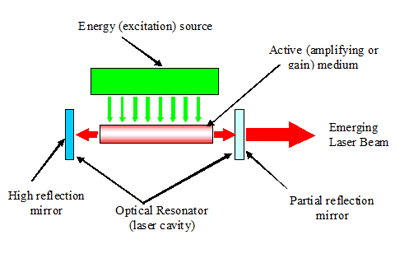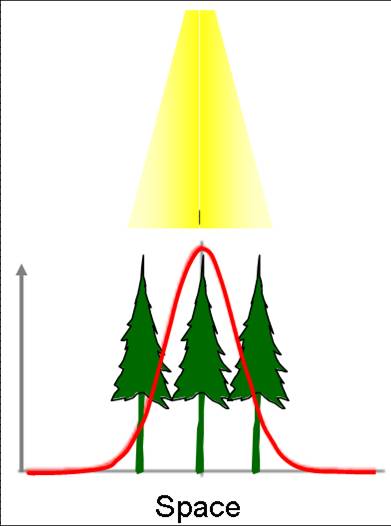Basic Principles of Lasers
This learning object covers basic principle of lasers and how they work, source of lasers and properties of laser pulse.
What is a laser?
The commonly used term ‘Laser’ is an acronym for ‘Light Amplification by Stimulated Emission of Radiation’. A laser is an optical device which, when stimulated by an energy source, emits a monochromatic (i.e. covering only a very small portion of the electromagnetic spectrum) radiation beam/pulse in the same direction with waves of one phase.
Lasers are classified according to the material used as the radiation source:
- Gas laser
- Solid-state laser
- Semiconductor laser
Only some semi-conductor or solid-state lasers emit radiation of sufficient energy levels for long distance mapping with suitable collimation (this means that the emitted electromagnetic beams/pulses are parallel and do not disperse with distance) for topographic mapping.
Laser systems
A typical laser system has the following components:
- Active material of laser: energy levels of electrons within the atoms of this active material are raised by an energy source. The active material in solid-state laser scanners for topographic applications may be: neodymium-doped yttrium aluminium garnet (Nd:YAG) and in a semiconductor laser scanner: gallium arsenide (GaAs). These two different types of laser source are explained in more detail below.
- Energy source: the energy is used to initiate and continue (pumping) laser action. Energy sources can be optical (high-intensity discharge lamp or laser diode) or electrical.
- Two mirrors: one fully reflective and one semi-reflective.
There are two categories of laser source:
Solid-state laser
In a solid state laser, the energy source raises the energy levels of electrons to unstable levels; electrons then begin to return to normal state passing through a metastable level. Continuous “pumping” of energy ensures most electrons remain metastable. Electrons in a metastable state emit energy in the form of photons and adjacent atoms are then triggered to emit photons of the same frequency and phase (spontaneous emission). These photons move up and down the axis/rod of the laser reflecting off fully reflective and partially reflective mirrors until energy levels are high enough for the energy to pass through the partially reflective mirror as a pulse or beam of laser radiation.
Semiconductor laser
Semiconductor materials exhibit the electrical properties of electrical diodes. The active material contains an upper layer containing impurities resulting in deficiency in electrons and positive holes (p type material). The lower layer has impurities resulting in excess electron charges (n type material). The active layer is a p-n junction between p and n layers. When an electric current is passed through the active layer electrons enter the active layer from the p and n layers. Electrons stimulated by electrical energy passing through the active layer gradually fall back to a state of lower energy exhibiting electroluminescence and emit photons. Laser action can be generated by placing a semi-reflective surface at one end of the active material and a fully reflective surface (often gold) on the other.
Laser Pulses
Laser pulses have 4 key characteristics:
- Monochromaticity: a laser emits in only a very small portion of the electromagnetic spectrum
- Intensity: in that narrow range of wavelengths the laser’s output energy can exceed that of the sun or any other known source.
- Directionality: a laser emits light only in a very well defined direction.
- Coherence: lasers emit light at only one phase
An emitted laser pulse passes through a lens to expand the beam and minimise its divergence. A fraction of the emitted radiation is diverted by a beam splitter to a photodiode whose signal triggers a time counter. The reflected pulse is detected by a receiving lens and then reflected via a prism onto another photodiode to stop the time counter. With long range scanners (eg. airborne LiDAR/ spaceborne) a large receiving lens/mirror is needed to detect a faint reflected signal. Even when distances are short, laser pulses will diverge and scatter (due to particles in the atmosphere) resulting in the need to amplify the received signal electrically. The time taken for an emitted pulse to return is measured by the time counter and can be used to calculate slant range using the known speed of light. Multiple return pulses from a single object (eg. a tree) can be measured and recorded within the resolution of the laser scanner.
The length of pulse is an important characteristic of laser scanning, determining how many multiple returns from a single emitted pulse can be measured. A pulse of 10ns would have a pulse length of 3m at the speed of light. The speed of electromagnetic energy is 300,000 km/s, meaning a measured range of 1m would require timing of the pulse at 1/300,000,000 of as second, a measured resolution of 1cm would require pulse timing at 3×10-11. The quality and temporal resolution of the timer and the start/stop triggers therefore determine the accuracy of the laser ranger/scanner.
The measuring resolution of a laser ranger is limited by the quality of the time counter and the length of the emitted pulse. The ability to detect a pulse also controls the accuracy and resolution of laser scanners, as the intensity of energy varies horizontally and vertically within a pulse. This causes differential reflection off objects and distorts returned pulses meaning measuring capacity of a laser scanner is limited by it’s ability to detect the trailing edges of a pulses.
The pulse repetition frequency is partly determined by the distance of the scanner from the object. Over short distances it is possible to make a large number of measurements in a short period of time whereas for spaceborne or airborne sensors this capacity is diminished due to the longer time interval between emitted and received pulses. A recent development is having multiple laser pulses being emitted and received simultaneously thus increasing the point repetition frequency of longer range scanners.
Beam Divergence and Laser Footprint
Despite efforts to collimate the beam/pulse on leaving the laser, it will still have diverged to illuminate a circular region on the on the object of scanning. The greater the angular spread of the beam the larger the circular region covered on the object. If the object on the ground has a varying topography the returned pulse will be an average of reflections from the area and a resultant loss of information will occur.
Reflectivity
Reflectance is defined as the ratio of incident radiation on a given object/surface against reflected radiation from the surface. The reflective properties of a surface, extent to which it scatters radiation, and the wavelength of the emitted pulse all influence the strength of returned signal to the sensor. The angle of incidence for the emitted pulse/beam will influence reflection detected at the sensor. If an airborne LiDAR scanner scans directly above a forest it can enable the beam/pulse to penetrate the canopy where as this capacity would be lost with an increasing scan angle.
Causes of loss of laser pulse/beam power
- Divergence of emitted beam/pulse
- Limited reflectance/ reflective properties of object being scanned
- On both the transmitted and reflected pulse, scattering by dust particles and water droplets can weaken the signal.
The returned pulse will therefore only be a fraction of the emitted pulse, hence the returned signal must be amplified and noise filtered out.

